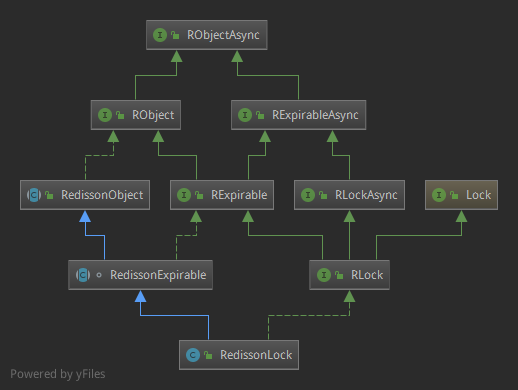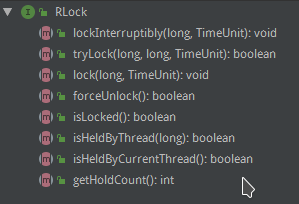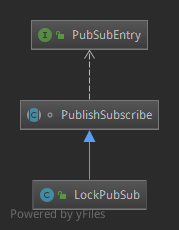2019独角兽企业重金招聘Python工程师标准>>> ![]()
RedissonLock继承结构:
RLock接口中定义的方法:主要分析tryLock()实现。
**(一) RedissonLock#tryLock:**加锁逻辑
public boolean tryLock(long waitTime, long leaseTime, TimeUnit unit) throws InterruptedException {
long time = unit.toMillis(waitTime);// 等待时间
long current = System.currentTimeMillis();
final long threadId = Thread.currentThread().getId();// 使用当前线程ID,实现重入锁
Long ttl = tryAcquire(leaseTime, unit, threadId);// 尝试获取锁
// lock acquired
if (ttl == null) {// 没有过期时间,未上锁,直接返回获取成功
return true;
}
time -= (System.currentTimeMillis() - current);
if (time <= 0) {// 等待时间已超时
acquireFailed(threadId);
return false;
}
current = System.currentTimeMillis();
// 订阅锁的队列,等待锁被其余线程释放后通知
// 通过Redis的Channel订阅监听队列,subscribe内部通过信号量semaphore,再通过await方法阻塞,内部其实是用CountDownLatch来实现阻塞,获取subscribe异步执行的结果,来保证订阅成功
final RFuture subscribeFuture = subscribe(threadId);
if (!await(subscribeFuture, time, TimeUnit.MILLISECONDS)) {// 阻塞等待subscribe的future的结果对象(即分布式解锁消息的结果)
if (!subscribeFuture.cancel(false)) {
subscribeFuture.addListener(new FutureListener() {
@Override
public void operationComplete(Future future) throws Exception {
if (subscribeFuture.isSuccess()) {
unsubscribe(subscribeFuture, threadId);
}
}
});
}
acquireFailed(threadId);
return false;
}
try {
time -= (System.currentTimeMillis() - current);
if (time <= 0) {// subscribe方法调用超时,取消订阅,不再继续申请锁
acquireFailed(threadId);
return false;
}
while (true) {
long currentTime = System.currentTimeMillis();
ttl = tryAcquire(leaseTime, unit, threadId);// 再次尝试申请锁
if (ttl == null) {// 获得锁,返回
return true;
}
time -= (System.currentTimeMillis() - currentTime);
if (time <= 0) {// 超时
acquireFailed(threadId);
return false;
}
// waiting for message 等待订阅的队列消息
currentTime = System.currentTimeMillis();
// 通过信号量(共享锁)阻塞,等待解锁消息(这一点设计的非常精妙:减少了其他分布式节点的等待或者空转等无效锁申请的操作,整体提高了性能)
if (ttl >= 0 && ttl < time) {// 在ttl内,从Entry的信号量获取一个许可(除非被中断或者一直没有可用的许可)
getEntry(threadId).getLatch().tryAcquire(ttl, TimeUnit.MILLISECONDS);
} else {// 在等待剩余时间内...
getEntry(threadId).getLatch().tryAcquire(time, TimeUnit.MILLISECONDS);
}
time -= (System.currentTimeMillis() - currentTime);
if (time <= 0) {// 超时
acquireFailed(threadId);
return false;
}
}
} finally {
unsubscribe(subscribeFuture, threadId);// 无论是否获得锁,都要取消订阅解锁消息
}
// return get(tryLockAsync(waitTime, leaseTime, unit));
}
## RedissonLock#getEntry -> RedissonLock#getEntryName
protected String getEntryName() {
return id + ":" + getName();// 客户端实例ID+锁名称来保证多个实例下的锁可重入
}
0x0001:**RedissonLock#tryAcquire:**尝试获取锁
private Long tryAcquire(long leaseTime, TimeUnit unit, long threadId) {
return get(tryAcquireAsync(leaseTime, unit, threadId));
}
## RedissonObject#get
protected final CommandAsyncExecutor commandExecutor;
protected final V get(RFuture future) {
return commandExecutor.get(future);
}
0x0010:**RedissonLock#tryAcquireAsync:**异步尝试获取锁,异步调用,get方法阻塞
## RedissonLock#tryAcquireAsync
private RFuture tryAcquireAsync(long leaseTime, TimeUnit unit, final long threadId) {
if (leaseTime != -1) {// 起租时间不为空
return tryLockInnerAsync(leaseTime, unit, threadId, RedisCommands.EVAL_LONG);
}
// lockWatchdogTimeout = 30 * 1000默认30秒
RFuture ttlRemainingFuture = tryLockInnerAsync(commandExecutor.getConnectionManager().getCfg().getLockWatchdogTimeout(), TimeUnit.MILLISECONDS, threadId, RedisCommands.EVAL_LONG);
ttlRemainingFuture.addListener(new FutureListener() {
@Override
public void operationComplete(Future future) throws Exception {
if (!future.isSuccess()) {
return;
}
Long ttlRemaining = future.getNow();
if (ttlRemaining == null) {// 拿到锁
scheduleExpirationRenewal(threadId);
}
}
});
return ttlRemainingFuture;
}
## RedissonLock#scheduleExpirationRenewal Redisson避免死锁方案,避免锁未被释放。
## 若未设置过期时间的话,redission默认的过期时间是30s,同时未避免锁在业务未处理完成之前被提前释放,Redisson在获取到锁且默认过期时间的时候,会在当前客户端内部启动一个定时任务,每隔internalLockLeaseTime/3的时间去刷新key的过期时间,这样既避免了锁提前释放,同时如果客户端宕机的话,这个锁最多存活30s的时间就会自动释放
if (expirationRenewalMap.containsKey(getEntryName())) {
return;
}
Timeout task = commandExecutor.getConnectionManager().newTimeout(new TimerTask() {
@Override
public void run(Timeout timeout) throws Exception {
RFuture future = commandExecutor.evalWriteAsync(getName(), LongCodec.INSTANCE, RedisCommands.EVAL_BOOLEAN,
"if (redis.call('hexists', KEYS[1], ARGV[2]) == 1) then " +
"redis.call('pexpire', KEYS[1], ARGV[1]); " +
"return 1; " +
"end; " +
"return 0;",
Collections. 0x0011:**CommandAsyncService#get:**包装了CountDownLatch是为了支持线程可中断操作
public V get(RFuture future) {
if (!future.isDone()) {// Task还没执行完成
final CountDownLatch l = new CountDownLatch(1);// 设置一个单线程的同步控制器
future.addListener(new FutureListener() {
@Override
public void operationComplete(Future future) throws Exception {
l.countDown();// 操作完成
}
});
boolean interrupted = false;
while (!future.isDone()) {
try {
l.await();
} catch (InterruptedException e) {
interrupted = true;
break;
}
}
if (interrupted) {
Thread.currentThread().interrupt();
}
}
// commented out due to blocking issues up to 200 ms per minute for each thread
// future.awaitUninterruptibly();
if (future.isSuccess()) {
return future.getNow();
}
throw convertException(future);
}
0x0100:**RedissonLock#tryLockInnerAsync:**真正执行的是一段具有原子性的Lua脚本,并且最终也是由CommandAsynExecutor去执行。使用Lua的好处:Redis会将整个脚本作为一个整体执行,中间不会被其他命令插入。因此在编写脚本的过程中无需担心会出现竞态条件,无需使用事务。
RFuture tryLockInnerAsync(long leaseTime, TimeUnit unit, long threadId, RedisStrictCommand command) {
internalLockLeaseTime = unit.toMillis(leaseTime);// 锁过期时间-毫秒
// getName() - 逻辑锁名称:比如方法名+名称
return commandExecutor.evalWriteAsync(getName(), LongCodec.INSTANCE, command,"Lua脚本",Collections. 锁的实际存储类型是hash。KEY[1]->逻辑锁名称 ARGV[2]->线程级别的锁名称
if (redis.call('exists', KEYS[1]) == 0) then
redis.call('hset', KEYS[1], ARGV[2], 1);
redis.call('pexpire', KEYS[1], ARGV[1]);
return nil;
end;
if (redis.call('hexists', KEYS[1], ARGV[2]) == 1) then
redis.call('hincrby', KEYS[1], ARGV[2], 1);
redis.call('pexpire', KEYS[1], ARGV[1]);
return nil;
end;
return redis.call('pttl', KEYS[1]);
分析这段Lua脚本:
- 检查锁名称是否存在,如果不存在,获取成功,同时设置线程级别锁名称,设置过期时间为
internalLockLeaseTime - 如果检查存在KEYS[1], ARGV[2],获取成功,自增1,记录重入的次数,更新过期时间
- 如果key不存在,直接返回key的剩余过期时间
0x0101:**RedissonLock#acquireFailed:**把该线程从获取锁操作的等待队列中直接删掉
private void acquireFailed(long threadId) {
get(acquireFailedAsync(threadId));
}
## RedissonFairLock#acquireFailedAsync
@Override
protected RFuture acquireFailedAsync(long threadId) {
return commandExecutor.evalWriteAsync(getName(), LongCodec.INSTANCE, RedisCommands.EVAL_VOID,
"local firstThreadId = redis.call('lindex', KEYS[1], 0); " +
"if firstThreadId == ARGV[1] then " +
"local keys = redis.call('zrange', KEYS[2], 0, -1); " +
"for i = 1, #keys, 1 do " +
"redis.call('zincrby', KEYS[2], -tonumber(ARGV[2]), keys[i]);" +
"end;" +
"end;" +
"redis.call('zrem', KEYS[2], ARGV[1]); " +
"redis.call('lrem', KEYS[1], 0, ARGV[1]); ",
Arrays. 0x0110:**PublishSubscribe#subscribe:**订阅消息
final AtomicReference listenerHolder = new AtomicReference();
// 根据channelName拿到信号量,channelName=UUID+":"+name,对应一个锁
final AsyncSemaphore semaphore = subscribeService.getSemaphore(new ChannelName(channelName));
final RPromise newPromise = new RedissonPromise() {
@Override
public boolean cancel(boolean mayInterruptIfRunning) {
return semaphore.remove(listenerHolder.get());
}
};
Runnable listener = new Runnable() {
@Override
public void run() {
E entry = entries.get(entryName);
if (entry != null) {
entry.aquire();
semaphore.release();
entry.getPromise().addListener(new TransferListener(newPromise));
return;
}
E value = createEntry(newPromise);
value.aquire();
E oldValue = entries.putIfAbsent(entryName, value);
if (oldValue != null) {
oldValue.aquire();
semaphore.release();
oldValue.getPromise().addListener(new TransferListener(newPromise));
return;
}
RedisPubSubListener **(二) RedissonLock#unlock:**解锁逻辑
@Override
public void unlock() {
try {
get(unlockAsync(Thread.currentThread().getId()));
} catch (RedisException e) {
...
}
}
0x0001:**RedissonLock#unlockAsync:**异步解锁
@Override
public RFuture unlockAsync(final long threadId) {
final RPromise result = new RedissonPromise();
RFuture future = unlockInnerAsync(threadId);// 此处Redis实现
future.addListener(new FutureListener() {
@Override
public void operationComplete(Future future) throws Exception {
if (!future.isSuccess()) {
cancelExpirationRenewal(threadId);
result.tryFailure(future.cause());
return;
}
Boolean opStatus = future.getNow();
if (opStatus == null) {
IllegalMonitorStateException cause = new IllegalMonitorStateException("attempt to unlock lock, not locked by current thread by node id: "
+ id + " thread-id: " + threadId);
result.tryFailure(cause);
return;
}
if (opStatus) {// 解锁成功之后取消更新锁expire的时间任务,针对于没有锁过期时间的
cancelExpirationRenewal(null);
}
result.trySuccess(null);
}
});
return result;
}
0x0010:**RedissonLock#unlockInnerAsync:**当其他线程释放锁的时候,会同时根据锁的唯一通道publish一条分布式的解锁信息,接收到分布式消息后, 等待获取锁的Semaphore中的监听队列中的listenser线程可重新申请锁。
protected RFuture unlockInnerAsync(long threadId) {
return commandExecutor.evalWriteAsync(getName(), LongCodec.INSTANCE, RedisCommands.EVAL_BOOLEAN,"Lua脚本",Arrays. 拿出来Lua看看如何实现的:KEY[1]->逻辑锁名称 KEY[2]->getChannelName() ARGV[1]->0L ARGV[2]->过期时间 ARGV[3]->线程级别的锁名称
if (redis.call('exists', KEYS[1]) == 0) then
redis.call('publish', KEYS[2], ARGV[1]);
return 1;
end;
if (redis.call('hexists', KEYS[1], ARGV[3]) == 0) then
return nil;
end;
local counter = redis.call('hincrby', KEYS[1], ARGV[3], -1);
if (counter > 0) then
redis.call('pexpire', KEYS[1], ARGV[2]);
return 0;
else
redis.call('del', KEYS[1]);
redis.call('publish', KEYS[2], ARGV[1]);
return 1;
end;
return nil;
分析这段Lua脚本:
- 如果键不存在,说明锁可以用了,发布锁释放消息后返回
- 如果锁不是被当前线程锁定,则返回nil
- Redisson支持重入,在解锁的时候,引用数减1
- 如果重入数>0,重新设置过期时间
- 如果重入数>=0,说明锁可以使用了,发布锁释放消息后返回
**(三) LockPubSub#unlockMessage:**处理解锁消息
Redisson在LockPubSub中处理解锁消息,首先看一下LockPubSub继承结构:
PublishSubscribe#createListener
// 模板方法,提供给子类实现
protected abstract void onMessage(E value, Long message);
private RedisPubSubListener**LockPubSub:**解锁消息
public class LockPubSub extends PublishSubscribe {
public static final Long unlockMessage = 0L;// 解锁消息,redis执行lua返回值
public static final Long readUnlockMessage = 1L;
@Override
protected RedissonLockEntry createEntry(RPromise newPromise) {
return new RedissonLockEntry(newPromise);
}
@Override
protected void onMessage(RedissonLockEntry value, Long message) {
if (message.equals(unlockMessage)) {// 解锁消息
Runnable runnableToExecute = value.getListeners().poll();
if (runnableToExecute != null) {
runnableToExecute.run();
}
// 释放一个,唤醒等待的entry.getLatch().tryAcquire去再次尝试获取锁
value.getLatch().release();
} else if (message.equals(readUnlockMessage)) {
while (true) {// 如果还有其他Listeners回调,也唤醒执行
Runnable runnableToExecute = value.getListeners().poll();
if (runnableToExecute == null) {
break;
}
runnableToExecute.run();
}
value.getLatch().release(value.getLatch().getQueueLength());
}
}
}


